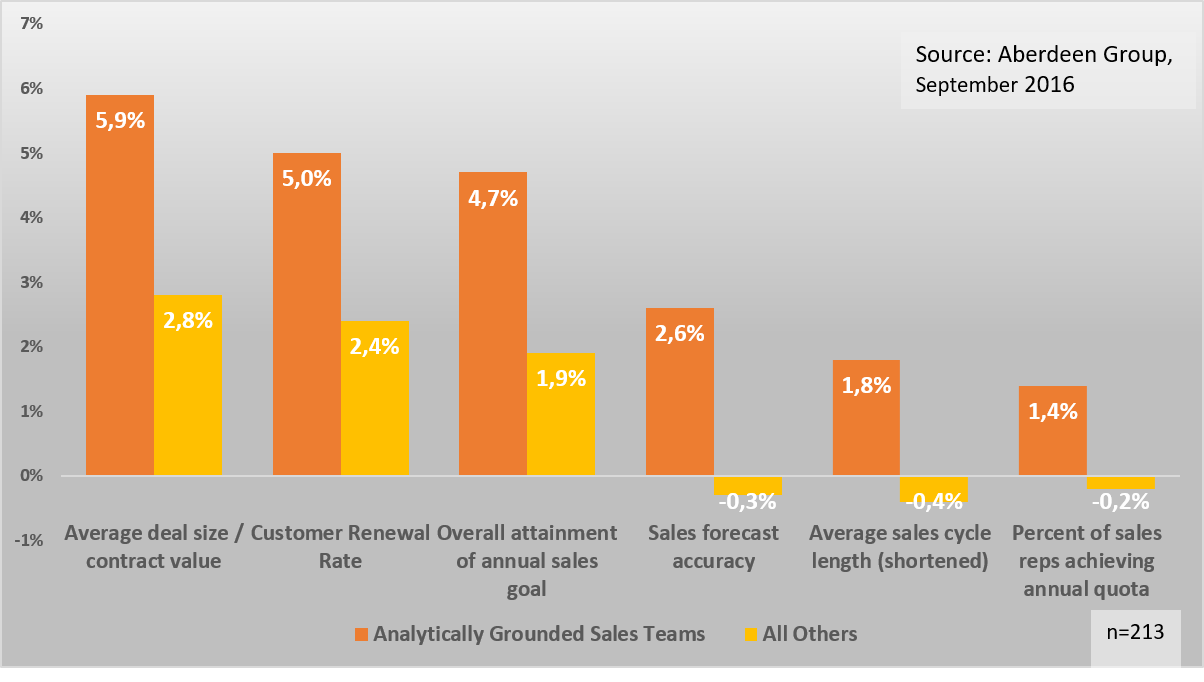The formal concept to manage this challenge in business is called Sales Pipeline Management. It´s bridging today´s deal-by-deal business execution with the projected business attainment on an opportunity-by-opportunity basis. While, it is the shared formal concept for all stakeholders, it allows for different perspectives:
While there are plenty of publications on Pipeline Management, I would like to share some perspective, why Quality must beat Quantity! Ideally, all your opportunities convert to business and contribute to the goal attainment. However, reality is very different. Deals are slipping into future quarters, they close smaller than expected or simply are lost. Let me introduce some commonly used concepts to address the lack of control on the pipeline:
In essence, you can either further mobilize your demand generation engine to put more deals into the pipeline (increase Quantity) or lose less from it (increase WinRate) - either way, you will need to prepare for the unexpected. Important to keep in mind that both approaches are limited by available sales capacity of the organization. As far as the laws of mathematics refer to reality, they are not certain; and as far as they are certain, they do not refer to reality. The Spreadsheet Acrobats will tell you that the required future Pipeline Threshold to hit your future sales target ("pipeline coverage") will be the future target to go plus an % uplift. The amount of required % uplift is defined by the % amount of historically lost deals. In other words, we set the pipeline coverage goal high enough so, we -hopefully- cater for potential future losses.
The mathematical approach alone is not getting you on the safe side. You end up in an unhealthy race fighting lost opportunities with more demand generation. However, the more pipeline volume we expect, the more difficult it is to find sufficient deals and the harder it gets to reach a similar success rate again. Fighting the tendency of dropping WinRates through incremental volume requirements we can call the Matryoshka Effect in Pipeline Coverage Requirements - the Pipeline Coverage targets keep going up while WinRates are trending downwards. In reality, many leaders still prefer to drive the hard fact based, quantitative approach over qualitative coaching. The reason is simple: It´s easier to scale pipeline generation within a sales organization (all hands on deck!"), than coaching sellers, partners and marketing for elevated deal quality. The only way to escape Matryoshka’s appetite for more is by putting focus on the qualitative approach to deals, both on the Demand Generation and on the Deal Management side. Increasing the number of healthy deals (and the healthy meals for Matryoshka) will get your pipeline into a stable, healthy state. Give it a serious try, put focus on the organizational capability and you will be surprised, both by the qualitative and the quantitative effects it triggers.
The very practical approach of Coaching for Pipeline Success [Keith Rosen] works well for me but, Training alone doesn't develop champions. Leaders do!
0 Comments
I don't know anything, but I do know that everything is interesting if you go into it deeply enough.
This usually is the point where measuring the world starts and big data is put into action. It begins with identifying statistically significant parameters. Try to understand what sets a successful contract renewal apart from those which did not renew. If you want to go beyond anecdotal evidence, a lot of data points are involved, but the effort is worth it. Aberdeen Group research states that Analytically Grounded Sales Teams average a 2.7 times greater annual increase in customer renewal rates. Meanwhile, such data analysis is well supported by BI tools or even Artificial Intelligence engines and it is backed by external business consultant experience.
Taking the recurring business scientifically to the next level implies a lot of work but it is the right choice in the digital era. Even if you decide to start small, next time you assess the feedback of your customer satisfaction survey with your teams, make sure you especially understand where the bullet holes are missing - it might well be your blind spot hiding the lethal risk to your business mission.
Account Planning means planning for results. In a number driven world of sales, the decomposition of an aspired revenue goal is psychologically the first step to accepting the challenge. While SMART goals and respective objectives may well fit on a small napkin, they by no means are the plan. I would even argue that it is the wrong end to start with - relevant account plans are starting with the customer. In recent years, Business-to-Business sales has evolved in various dimensions, redefining how we engage with customers:
Account Planning is a reflection on the evolution in sales but even more, so it is a yardstick on the sophistication of your teams work - what a great coaching opportunity or moment to personally benefit the customer relationship in form of executive sponsorship. Imagine the business potential of getting the perception right by moving away from a necessary evil and abandoning the disrespect which a napkin implies.
Probably it is both, the no fear approach rooted in the own strength and the believe, that innovation should be routine - The inventor produces ideas, the entrepreneur “gets things done” [J. Schumpeter, 1947]. ... There's an angel, with a hand on my head
Closing my pleasant conversation with the gentleman, I directly asked him on his personal fear. He responded that in future quality journalism may commercially not find it´s sustainable place. However, messing with the checks and balances in our democratic societies would get him sleepless nights. Auch der stärkste Mann schaut einmal unters Bett.
For example, the authors are not asking why “CRM self-reported data maybe inherently flawed” but propose the approach “to analyze the digital exhaust of calendar and email metadata” instead. We can be rest assured that it will be 10 AM again and that time will tell how many of their top performing sellers are willing to accept the proposed micro management approach to optimization. It´s clear that maintaining business data in CRM is not the first thing a seller will fall in love with but why should metadata from calendar, mail or any other app maybe in better shape or even be more insightful than explicit business information? - Data quality is about discipline but sustainability only can be achieved where relevant business conversation drives respective demand for it. Times of the Lone Wolves in sales are over and contemporary solution selling approaches mandate efficient teamwork. The better you coach this in every interaction with your sellers, the more you inherently drive demand for systematic alignment. This will make the case for efficient Time Management and, ultimately it shows the difference between a metering tool and CRM as a sales productivity engine. Selling into complex enterprises is a time intense endeavor, so let´s maximize selling time for your teams, e.g. balancing all internal work with the amount of time they need to spend properly serving customers. Time Management also remains a key enabling factor on seller level, requiring to systematically coach and develop every individual – probably starting with yourself! If you want to learn more on how to practically approach Time Management, Keith Rosen recently published his new book: “Own Your Day!”. It´s worth reading and opens eyes on why your calendar may yet not be the ideal starting point to conclude optimization from. Either way, Coaching or Inspection - you decide but be aware: No one expects the Spanish Inquisition! 😉
How come, we seem to struggle with predicting our potential future business attainment? – We are dealing with a so called “Information Inefficiency”, a risk sourcing from an information deficit. It means we don´t know what will happen until it happened. So, in theory gathering information and managing deals on time will mitigate this risk and our forecast accuracy problem is solved. However, the subject is far more complex since we are dealing with people, organizations and respective underlying political dynamics. Science refers to this risk category as “Alignment Inefficiency”. It describes the domain of risk sourcing from conflicting interests and -incentives within an organization. This important fact makes Forecast Management an interesting cultural aspect and sets it apart from sheer business discipline efforts – Forecast Management is all about Leadership! Unarguably, the sales teams play a key role in mastering the forecast accuracy but we should not confuse Deal Management accountability on Seller level or Pipeline Management accountability on Management level with Forecast Management ownership on Leadership suite. Forecasting is a team sport which, when done properly involves your whole organization to varying degree. Teaming up for success requires your people speaking the same language. Are your teams using the same taxonomy, following the same standards in assessing the business and is the final forecast puzzle seamlessly fitting together as one, ultimately reflecting the organizational commitment? Sellers know their customers and deals best. The Bottom-Up approach is a good start but how do you assess required information without additionally distracting your motivated sellers from what they like best, doing business? – Seller Readiness and Deal Coaching are the first priorities. Getting this right, in right dose, is your ticket into a predictable deal management and a solid forecast foundation. The Best Way To Predict The Future Is To Create It! When talking about the next level -the sales management assessment- we are already into the usual conflict of interest – ambition or reality. Clear answer: ambition belongs into the budget, business plan and the actual deal management, while reality is the main ingredient to the forecast. The Risks (Timing- and Alignment-Risk) remain as variables in the decision making. Having variables means options and scenarios to be considered during the forecast assessment. Will the Risk deal offset another Upside or will the Risks/Upsides add up? … Do I have to adjust my P&L now, based on my Forecast or will the available resource still improve the business outlook in current business period? – It´s not easy but it all requires a deep understanding and clear sight on your business to get it right. The view from the top in an organization provides us with the 360-degree view on the business to precisely navigate the curvy road ahead. Looking back on historic data and trendlines is tempting but also dangerous in anticipating the future. We easily miss the game changing moment in our market. Mark Twain well framed it: “History doesn't repeat itself, but it does rhyme.” Even more so, it generates a false sense of security which distracts from analyzing current business dynamics or going deep on deal progression. Strong management commitment, insights on operational risks, specific deal challenges and visibility on the underlying decision making processes should equip us well to take a balanced decision on our forecast and conclude orchestrated corrective action on our business to come. Finally, measuring Forecast precision is a helpful indication when it comes to supporting a continuous organizational learning process. Using it as an organizational goal, it triggers counterproductive corrective action on the symptoms, not on the cause. The Forecast ought to be your uncompromised view on the future, it will not change the weather nor your business but it allows us to choose where to go or which action to take – cultivate your Forecast integrity with caution, don´t allow to compromise it with dishonesty nor load it with wrong ambition. You can shoot the frog for bad news but like it or not, your Forecast accuracy is ultimately reflecting the level of trust within your organization.
|
Andreas Engelis an experienced business leader working 25+ year in high-tech industry - leading, growing and transforming high-performance sales organizations, balancing short term results with long term strategy to drive new business growth. CATEGORIES
All
ARCHIVES
April 2020
|











